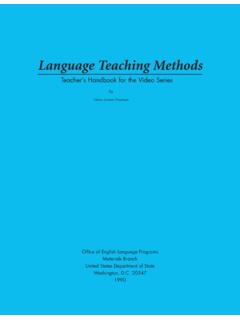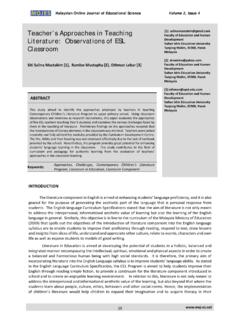Transcription of Living vs. Non-Living | 5E Lesson Plan for Grades K-2 [PDF]
1 SUMMARYS tudents use knowledge of the characteristics of Living things to categorize objects as Living or : 15-25 minutes. CORRELATIONK-LS1-1. Use observations to describe patterns of what plants and animals (including humans) need to survive. 2019 1 Lesson PLANLIVING VS NON- Living THINGSGRADES K-2 Disciplinary Core IdeasConnections to Classroom ActivityScience & Engineering PracticesConnections to Classroom ActivityAnalyzing and Interpreting Data Analyzing data in K 2 builds on prior experiences and progresses to collecting, recording and sharing observations (firsthand or from media) to describe patterns in the natural world in order to answer scientific questions. (K-LS1-1) : Organization for Matter and Energy Flow in OrganismsAll animals need food in order to live and grow. They obtain their food from plants or from other animals. Plants need water and light to live and grow. (K-LS1-1) Students will analyze different pictures to classify them as either Living or non- Living .
2 Students distinguish between what Living things need to survive (nutrients, water, growth, reproduction) versus non- Living things which do not need anything to survive since they are not, and have never been, to Video Pet rock 2 Hula hoops 2 Large labels ( Living things and non- Living ) Set of pictures of Living and non- Living thingsDIY Activity (per group) Clipboard with paper Pencil Nature area like a garden, park, backyard, etc. MATERIALS2 2019 ConceptsConnections to Classroom ActivityPatternsPatterns in the natural and human designed world can be observed and used as evidence. (K-LS1-1) The students observe that Living and non- Living things have different structures and functions. ENGAGEShow students your pet rock. Tell them his/her name and that you have a little bed for him/her in a box. Ask students, What do you think I should feed my pet rock? or Does my pet rock need food to survive? This will hopefully lead to the idea that the rock is not actually alive; it s just a pretend pet.
3 Segue to the Lesson by telling students they will be exploring Living and non- Living things by classifying pictures into non- Living or Living . EXPLORES teps1) Place two hula hoops on the floor next to each ) Label one Living and the other with non- Living . 3) Give each student in your class a picture of one of the Living or non- Living things you have printed and cut ) Have each student place their picture inside what they believe is the correct hula ) Gather your students in a circle around the two hula ) Ask the students if any of the pictures need to be switched to a different location. If so, have them explain what needs to be switched and why. EXPLAINHave a few students share why they chose to place their picture where they did. Explain that to tell if something is Living or non- Living we have to ask ourselves three it grow? Does it get bigger over time?Does it need nutrients? That means taking in things like food and water. Does it reproduce?
4 That means making more of it. Go through these questions and make a conclusion with a few of the items your class selects from inside the hoops. EVALUATES tudents can play the online Kahoot! quiz game located below the video which provides downloadable scores at the end of the quiz game. Alternatively, you can use the paper quiz or the exit ticket questions. All these resources are located below the video in the Assessment section. ELABORATEGo on a nature walk around the school and have student identify Living and non- Living things with their new understanding. Students could bring a clip board and paper to record their observations through pictures or words by splitting the paper into the two columns of Living and non- Living . Next Generation Science Standards is a registered trademark of Achieve, Inc. A non-profit dedicated to raising academic standards and graduation requirements. 2019 3 EXTENSIONFor older or more advanced students you could introduce the vocabulary biotic and abiotic.
5 Biotic means Living or once Living , so this can include dead trees or leaves. Abiotic means not Living and never was Living . These vocabulary words are generally introduced in higher Grades . Read the book Living or Non- Living by Kelli Hicks. What s Alive by Kathleen Weidner Zoehfeld is also highly THE GENERATION GENIUS Living VS. NON- Living THINGS VIDEO AS A GROUP Then facilitate using the Discussion Questions. 4 2019 2019 5
![Weather vs. Climate | 5E Lesson Plan for Grades 3-5 [PDF]](/cache/preview/d/7/c/0/6/c/d/6/thumb-d7c06cd6fdf48a1bc04b4f1b0e7e23b6.jpg)
![Ecosystems | 5E Lesson Plan for Grades 3-5 [PDF]](/cache/preview/3/7/3/5/6/2/e/1/thumb-373562e11bfd5c636d56d01f227d09a5.jpg)
![What is Science? | 5E Lesson Plan for Grades K-2 [PDF]](/cache/preview/7/4/e/4/1/3/6/3/thumb-74e41363994c2eb466bf861bbe860774.jpg)
![Natural Disasters | 5E Lesson Plan for Grades 3-5 [PDF]](/cache/preview/8/0/9/c/e/7/2/f/thumb-809ce72f931e610fe94c698182f94da5.jpg)
![Weathering & Erosion | 5E Lesson Plan for Grades 3-5 [PDF]](/cache/preview/f/0/5/2/c/e/5/b/thumb-f052ce5b2e69fc2ea580a59cb704d9d6.jpg)
![Sun & Stars | 5E Lesson Plan for Grades 3-5 [PDF]](/cache/preview/3/8/9/6/7/a/2/9/thumb-38967a29ac1fe92fba7fa7d775945b90.jpg)

![Human Body Systems | 5E Lesson Plan for Grades 3-5 [PDF]](/cache/preview/5/3/7/d/5/f/0/a/thumb-537d5f0a980c7ec9133056914a11eb75.jpg)








